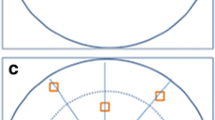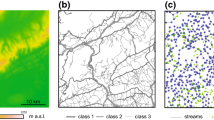Abstract
The compilation of all the available taxonomic and distributional information on the species present in a territory frequently generates a biased picture of the distribution of biodiversity due to the uneven distribution of the sampling effort performed. Thus, quality protocol assessments such as those proposed by Hortal et al. (Conservation Biology 21:853–863, 2007) must be done before using this kind of information for basic and applied purposes. The discrimination of localities that can be considered relatively well-surveyed from those not surveyed enough is a key first step in this protocol and can be attained by the previous definition of a sampling effort surrogate and the calculation of survey completeness using different estimators. Recently it has been suggested that records from exhaustive databases can be used as a sampling-effort surrogate to recognize probable well-surveyed localities. In this paper, we use an Iberian dung beetle database to identify the 50 × 50 km UTM cells that appear to be reliably inventoried, using both data derived from standardized sampling protocols and database records as a surrogate for sampling effort. Observed and predicted species richness values in the shared cells defined as well-surveyed by both methods suggest that the use of database records provides higher species richness values, which are proportionally greater in the richest localities by the inclusion of rare species.


Similar content being viewed by others
References
Adler PB, Lauenroth WK (2003) The power of time: spatiotemporal scaling of species diversity. Ecol Lett 6:749–756
Anderson RP (2003) Real vs artefactual absences in species distributions: tests for Oryzomys albigularis (Rodentia: Muridae) in Venezuela. J Biogeogr 30:591–605
Brooks T, da Fonseca GAB, Rodrigues ASL (2004) Species, data, and conservation planning. Conserv Biol 18:1682–1688
Chiarucci A, Maccherini S, De Dominicis V (2001) Evaluation and monitoring of the flora in a nature reserve by estimation methods. Biol Conserv 101:305–314
Colwell RK (2000) EstimateS: statistical estimation of species richness and shared species from samples (Software and User’s Guide). Version 6.0b1. Available at http://viceroy.eeb.uconn.edu/Estimates6/
Colwell RK, Coddington JA (1994) Estimating terrestrial biodiversity through extrapolation. Philos Trans R Soc Lond B Biol Sci 345:101–118
Chazdon RL, Colwell RK, Denslow JS, Guariguata MR (1998) Statistical methods for estimating species richness of woody regeneration in primary and secondary rain forests of north-eastern Costa Rica. In: Dallmeir F, Comiskey JA (eds) Forest biodiversity research, monitoring and modelling. Conceptual background and Old World case studies. Parthenon Publishing, Paris, France, pp 285–309
Dennis RLH (2001) Progressive bias in species status is symptomatic of fine-grained mapping units subject to repeated sampling. Biodivers Conserv 10:483–494
Dennis RLH, Hardy PB (1999) Targeting squares for survey: predicting species richness and incidence for a butterfly atlas. Global Ecol Biogeogr Lett 8:443–454
Dennis RLH, Thomas CD (2000) Bias in butterfly distribution maps: the influence of hot spots and recorder’s home range. J Insect Conserv 4:73–77
Dennis RLH, Sparks TH, Hardy PB (1999) Bias in butterfly distribution maps: the effects of sampling effort. J Insect Conserv 3:33–42
Dennis RLH, Shreeve TG, Isaac NJB, Roy DB, Hardy PB, Fox R, Asher J (2006) The effects of visual apparency on bias in butterfly recording and monitoring. Biol Conserv 128:486–492
Faith D (2002) Those complementarity analysis do not reveal extent of conservation conflict in Africa. Science debate. http://www.sciencemag.org/cgi/eletters/293/5535/1591/#381
Ferrier S (2002) Mapping spatial pattern in biodiversity for regional conservation planning: where to from here? Syst Biol 51:331–363
Funk VA, Richardson KS, Ferrier S (2005) Survey-gap analysis in expeditionary research: where do we go from here? Biol J Linn Soc Lond 85:549–567
Gaston KJ (1994) Rarity. Chapman & Hall, London
GBIF (2003) Global biodiversity information facility strategic plan. Available at www.gbif.org/GBIF_org/documents
Gotelli NJ, Collwell RK (2001) Quantifying biodiversity: procedures and pitfalls in the measurement and comparison of species richness. Ecol Lett 4:379–391
Graham CH, Ferrier S, Huettman F, Moritz C, Peterson AT (2004) New developments in museum-based informatics and applications in biodiversity analysis. Trends Ecol Evol 19:497–503
Gu W, Swihart RK (2004) Absent or undetected? Effects of non-detection of species occurrence on wildlife-habitat models. Biol Conserv 116:195–203
Guisan A, Zimmermann NE (2000) Predictive habitat distribution models in ecology. Ecol Modell 135:147–186
Guralnick RP, Hill AW, Lane M (2007) Towards a collaborative, global infrastructure for biodiversity assessment. Ecol Lett 10:663–672
Hortal J, Lobo JM (2005) An ED-based protocol for optimal sampling of biodiversity. Biodivers Conserv 14:2913–2947
Hortal J, Lobo JM, Martín-Piera F (2001) Forecasting insect species richness scores in poorly surveyed territories: the case of the Portuguese dung beetles (Col. Scarabaeinae). Biodivers Conserv 10:1343–1367
Hortal J, Borges PA, Gaspar C (2006) Evaluating the performance of species richness estimators: sensitivity to sample grain size. J Anim Ecol 75:274–287
Hortal J, Lobo JM, Jiménez-Valverde A (2007) Limitations of biodiversity databases: case study on seed-plant diversity in Tenerife (Canary Islands). Conserv Biol 21:853–863
Kadmon R, Oren F, Avinoam D (2004) Effect of roadside bias on the accuracy of predictive maps produced by bioclimatic models. Ecol Appl 14:401–413
Lamoreux JF, Morrison JC, Ricketts TH, Olson DM, Dinerstein E, McKnight MW, Shugart HH (2005) Global tests of biodiversity concordance and the importance of endemism. Nature 440:212
Lobo JM (2008) More complex distribution models or more representative data? Biodiv Inform (in press)
Lobo JM, Martín-Piera F (2002) Searching for a predictive model for Iberian dung beetle species richness based on spatial and environmental variables. Conserv Biol 16:158–173
Lobo JM, Baselga A, Hortal J, Jiménez-Valverde A, Gómez JF (2007) How does the knowledge about the spatial distribution of Iberian dung beetle species accumulates over time? Divers Distrib 13:772–780
Lyons KG, Brigham CA, Traut BH, Schwartz MW (2005) Rare species and ecosystem functioning. Conserv Biol 19:1019–1024
Martín-Piera F, Lobo JM (2003) Database records as a sampling effort surrogate to predict spatial distribution of insects in either poorly or unevenly surveyed areas. Acta Entomol Ibérica Macaronésica 1:23–35
Martín-Piera F, López-Colón JI (2000) Fauna Ibérica, vol 14. In: Ramos MA et al (eds) Coleoptera, Scarabaeoidea 1. Museo Nacional de Ciencias Naturales, CSIC, Madrid, 526 pp
Martínez-Meyer E (2005) Climate change and biodiversity: some considerations in forecasting shifts in species potential distributions. Biodivers Inform 2:42–55
Neldner VJ, Crossley DC, Cofinas M (1995) Using Geographic Information Systems (GIS) to determine the adequacy of sampling in vegetation surveys. Biol Conserv 73:1–17
Nelson BW, Ferreira CAC, da Silva MF, Kawasaki ML (1990) Endemism centers, refugia and botanical collection density in Brazilian Amazonia. Nature 345:714–716
Parnell JAN, Simpson DA, Moat J, Kirkup DW, Chantaranothai P, Boyce PC, Bygrave P, Dransfield S, Jebb MHP, Macklin J, Meade C, Middleton DJ, Muasya AM, Prajaksood A, Pendry CA, Poomar R, Suddee S, Wilkin P (2003) Plant collecting spread and densities: their potential impact on biogeographical studies in Thailand. J Biogeogr 30:193–209
Peterson AT, Slade NA (1998) Extrapolating inventory results into biodiversity estimates and the importance of stopping rules. Divers Distrib 4:95–105
Peterson AT, Navarro-Sigüenza AG, Benítez-Díaz H (1998) The need for continued scientific collecting: a geographic analysis of Mexican bird specimens. Ibis 140:288–294
Pulliam HR (1988) Sources, sinks and population regulation. Am Nat 132:652–661
Pulliam HR (2000) On the relationship between niche and distribution. Ecol Lett 3:349–361
Reddy S, Dávalos LM (2003) Geographical sampling bias and its implications for conservation priorities in Africa. J Biogeogr 30:1719–1727
Reutter BA, Helfer V, Hirzel AH, Vogel P (2003) Modelling habitat-suitability using museum collections: an example with three sympatric Apodemus species from the Alps. J Biogeogr 30:581–590
Ricklefs RE, Schluter D (1993) Species diversity: regional and historical influences. In: Ricklefs RE, Schluter D (eds) Species diversity in ecological communities. University of Chicago Press, Chicago, pp 350–363
Romo H, García-Barros E (2005) Distribución e intensidad de los estudios faunísticos sobre mariposas diurnas en la Península Ibérica e Islas Baleares (Lepidoptera, Papilionoidea y Hesperoidea). Graellsia 61:37–50
Romo H, García-Barros E, Lobo JM (2006) Identifying recorder-induced geographic bias in an Iberian butterfly database. Ecography 29:873–885
Soberón J, Llorente J (1993) The use of species accumulation functions for the prediction of species richness. Conserv Biol 7:480–488
Soberón J, Peterson AT (2004) Biodiversity informatics: managing and applying primary biodiversity data. Philos Trans R Soc Lond B 359:689–698
Soberón J, Llorente J, Benítez H (1996) An international view of national biological surveys. Ann Miss Bot Garden 83:562–573
Soberón JM, Llorente J, Oñate L (2000) The use of specimen-label databases for conservation purposes: an example using Mexican Papilionid and Pierid butterflies. Biodivers Conserv 9:1441–1466
Soberón J, Jiménez R, Golubov J, Koleff P (2007) Assessing completeness of biodiversity databases at different spatial scales. Ecography 30:152–160
Williams PH, Margules CR, Hilbert DW (2002) Data requirements and data sources for biodiversity priority area selection. J Bioscience 27:327–338
Zaniewski AE, Lehmann A, Overton JM (2002) Predicting species spatial distributions using presence-only data: a case study of native New Zealand ferns. Ecol Modell 157:261–280
Acknowledgements
This paper was supported by the Spanish MEC project CGL2004-0439/BOS, a Fundación BBVA Project, and The European Distributed Institute of Taxonomy (EDIT) project.
Author information
Authors and Affiliations
Corresponding author
Rights and permissions
About this article
Cite this article
Lobo, J.M. Database records as a surrogate for sampling effort provide higher species richness estimations. Biodivers Conserv 17, 873–881 (2008). https://doi.org/10.1007/s10531-008-9333-4
Received:
Accepted:
Published:
Issue Date:
DOI: https://doi.org/10.1007/s10531-008-9333-4




